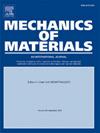含能材料微结构-性能关系的批量主动学习
IF 3.4
3区 材料科学
Q2 MATERIALS SCIENCE, MULTIDISCIPLINARY
引用次数: 0
摘要
聚合物粘结炸药(PBX)表现出复杂的微观结构-性能关系,特别是在其冲击-爆轰转变(SDT)行为中。传统的基于物理的模拟来探索这些关系在计算上是昂贵和耗时的,原因有很多。我们提出了一个材料信息学框架,利用批量主动学习来有效地研究PBX复杂的微观结构-宏观性质关系,显着减少了模拟时间。我们的框架集成了多输出高斯过程回归(MOGPR),以捕捉微观结构特征(包括空隙体积分数、形状和分布)与反应响应(以冲击压力和起爆距离为特征)之间的复杂关系。批量主动学习组件通过策略性地选择最具信息量的微观结构进行额外的模拟,有效地遍历微观结构空间,最大化信息增益,同时最小化计算成本。通过使用信息量最大的样本迭代改进MOGPR模型,加快了学习过程,提高了微观结构-性质关系的预测精度。我们的研究结果表明,模型收敛速度快,预测精度高,仅经过8次迭代,在留一交叉验证中,压力和跑步距离预测的r2得分均为0.97。这种方法有效地导航了不同的微观结构空间,揭示了控制PBX中SDT行为的关键因素。它还具有显著改进PBX材料设计和优化的潜力,能够开发具有增强性能和安全特性的定制炸药。本文章由计算机程序翻译,如有差异,请以英文原文为准。

Batch active learning for microstructure–property relations in energetic materials
Polymer-bonded explosives (PBX) exhibit complex microstructure–property relationships, particularly in their shock-to-detonation transition (SDT) behavior. Traditionally physics-based simulations to explore these relationships are computationally expensive and time-consuming for a number of reasons. We present a material informatics framework that leverages batch active learning to efficiently investigate the intricate microstructure-macroscopic property relationships for PBX, significantly reducing simulation time. Our framework integrates multi-output Gaussian Process Regression (MOGPR) to capture complex relationships between microstructural features (including void volume fraction, shape, and distribution) and reaction response (characterized by shock pressure and run-to-detonation distance). The batch active learning component efficiently traverses the microstructure space by strategically selecting the most informative microstructures for additional simulations, maximizing information gain while minimizing computational costs. By iteratively refining the MOGPR model with the most informative samples, we accelerate the learning process and improve the predictive accuracy of the microstructure–property relationships. Our results demonstrate rapid model convergence and high predictive accuracy, with scores of 0.97 for both pressure and run distance predictions in leave-one-out cross-validation after only eight iterations. This approach efficiently navigates the diverse microstructure space, uncovering key factors governing the SDT behavior in PBX. It also has the potential to significantly improve the design and optimization of PBX materials, enabling the development of tailored explosives with enhanced performance and safety characteristics.
求助全文
通过发布文献求助,成功后即可免费获取论文全文。
去求助
来源期刊

Mechanics of Materials
工程技术-材料科学:综合
CiteScore
7.60
自引率
5.10%
发文量
243
审稿时长
46 days
期刊介绍:
Mechanics of Materials is a forum for original scientific research on the flow, fracture, and general constitutive behavior of geophysical, geotechnical and technological materials, with balanced coverage of advanced technological and natural materials, with balanced coverage of theoretical, experimental, and field investigations. Of special concern are macroscopic predictions based on microscopic models, identification of microscopic structures from limited overall macroscopic data, experimental and field results that lead to fundamental understanding of the behavior of materials, and coordinated experimental and analytical investigations that culminate in theories with predictive quality.
 求助内容:
求助内容: 应助结果提醒方式:
应助结果提醒方式:


